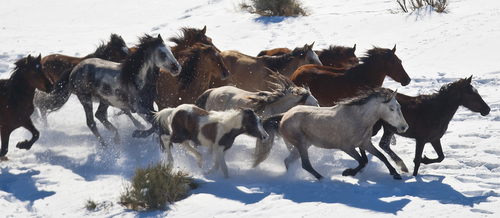This is an archived article that was published on sltrib.com in 2014, and information in the article may be outdated. It is provided only for personal research purposes and may not be reprinted.
Wild horse advocates say 35,000 people have filed comments with the Bureau of Land Management, urging the agency not to "appease" ranchers by rounding up wild horses in Utah's Iron and Beaver counties.
The BLM's comment period ended Friday on its environmental assessment for a series of roundups that would remove nearly 700 horses from the Bible Spring Complex of wild horse herd management areas.
The BLM in Washington has approved funding to remove 140 of the horses this summer from the Blawn Wash area, which is part of the complex and is state land where wild horses are not supposed to roam.
That is to be the first of several roundups over the next decade to reduce the number of wild horses, now estimated at 777, down to the range the agency deems appropriate — 80 to 170 horses.
Under pressure from ranchers whose cattle and sheep compete for scarce feed and water, Iron and Beaver counties are threatening to round up wild horses beginning in July if the BLM doesn't reduce their numbers. Eight horses already have been captured in a corral on private property. Ranchers also are suing the BLM, demanding it keep horses within their legal limits.
But wild horse advocates charged Monday that the BLM "plans to spend tens of millions of tax dollars to round up federally protected wild horses in order to give a handful of ranchers cheap, below-market grazing on our public lands."
Suzanne Roy, director of the American Wild Horse Preservation Campaign, said, "The problem is too many cows on our public lands, not too many wild horses," according to a news release.
The campaign believes the BLM's population estimate is inflated, since the agency last year published numbers showing fewer than 460 wild horses in the complex.
According to the environmental assessment, the BLM says its current estimate is based on a spring 2012 count by aircraft, and the fact that wild horse populations grow by close to 20 percent a year.
The assessment also says there are 2,744 cattle and 1,674 sheep grazing at least part of the year on grazing allotments in the herd management areas.
According to an analysis by wild horse advocates, the BLM allows 10 times as many livestock as wild horses to graze on public lands in Utah, and allocates 55 times more forage for livestock than for wild horses.



